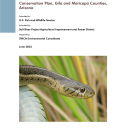PHOENIX—The U.S. Fish and Wildlife Service (Service), as the lead Federal agency, in conjunction with the U.S. Army Corps of Engineers (Corps), invites the public to review and comment on a proposed amendment to the Salt River Project (SRP) Roosevelt Dam Habitat Conservation Plan (RHCP). The amendment package includes a request for a proposed planned deviation from the Corps Water Control Manual; a draft Environmental Assessment (EA); and an application to amend the existing incidental take permit to add the northern Mexican gartersnake as a covered species, and to expand the permit area for incidental take of yellow-billed cuckoo, southwestern willow flycatcher, Yuma Ridgway’s rail, and bald eagle. The Service is accepting comments through September 5.
A Habitat Conservation Plan is a planning document designed to address Endangered Species Act (ESA) regulations in response to private development by authorizing the limited and unintentional take of listed species when it occurs incidental to otherwise lawful activities. The plan is designed not only to help landowners and communities but also to provide long-term benefits to species and their habitats.
SRP proposes deviating from the Corps’ manual for flood control, which directs dam and reservoir managers to release water from their flood-control capacity promptly after rainfall surges in order to keep that space available in the event of a catastrophic rainfall event. The proposed planned deviation, if approved, would provide SRP a regulatory framework to allow surges to fill up to 10 percent of Roosevelt Lake’s flood control space for up to 120 days, 100 days beyond the current maximum 20 days that the Corps manual requires, increasing the 22-mile-long lake by less than half a mile for an up to three out of five years (depending on precipitation and runoff). The extra water would allow boaters easier access to the lake and make more water available for hydropower and public use.
SRP is working with the Service to mitigate the effects of incidental take of threatened and endangered species with an amendment to their Habitat Conservation Plan for Roosevelt Dam and Lake. The original HCP was completed in 2003 and covers incidental take of the yellow-billed cuckoo and southwestern willow flycatcher with preserved land at Roosevelt Lake and along other streams to maintain habitat for those birds. SRP mitigates incidental take of bald eagles by funding Arizona Game and Fish Department (AZGFD) and U.S. Forest Service programs that monitor and protect eagles and their nesting attempts. It also mitigates take of Yuma Ridgway's rail by working with AZGFD to establish pond habitat on the Gila River.
SRP submitted the RHCP amendment in support of an application for an amended incidental take permit (permit) under the ESA. The RHCP amendment addresses effects from SRP's Roosevelt conservation storage actions to newly listed species and adds SRP's flood control operations. Flood control operations include normal operations, as directed by the Corps Water Control Manual, and a proposed “3 in 5-year planned deviation” to the Water Control Manual. The planned deviation to the Corps’ Water Control Manual, guiding Roosevelt Lake’s flood control space operations, is a federal action, as is the Service’s approval of an amended permit. SRP’s existing permit is for 50 years, expiring in 2053, and the amendment does not change the permit duration.
The proposed amendment to the RHCP includes the northern Mexican gartersnake, which was listed as threatened in 2014. To mitigate incidental take of the gartersnake, SRP proposes funding programs to reduce non-native predatory fish in lower Tonto Creek and replace them with native fish and frogs. These actions are intended to reduce fish predation of snakes and improve native prey persistence, abundance, and diversity. In addition, the amendment would expand the permit area for existing authorized incidental take for the yellow-billed cuckoo, southwestern willow flycatcher, Yuma Ridgway’s rail, and bald eagle. SRP's mitigation measures developed for the original HCP are robust enough to address additional minor effects to flycatchers, cuckoos, and bald eagles from the addition of flood control activities to the HCP. No additional effects are anticipated for rails.
SRP and the Service also evaluated and improved the take exceedance language for the bald eagle for conservation storage and additional flood control activities, addressing the bald eagle’s dynamic distribution and abundance. SRP is amending their existing RHCP under ESA for the bald eagle should the Service list the bald eagle as threatened or endangered in the future. Bald eagles were delisted from the ESA in 2007 and are now protected under the Bald and Golden Eagle Protection Act. A valid incidental take permit associated with an HCP constitutes a valid permit under the Bald and Golden Eagle Protection Act.
With the proposed RHCP amendment and proposed planned deviation, the public utility SRP is being proactive in working with the Service and the Corps in the way they are managing Modified Theodore Roosevelt Dam and Lake.
The draft EA addresses both the Service and Corps' National Environmental Policy Act (NEPA) responsibilities. The RHCP amendment is a combined ESA section 10(a)(1)(B) and ESA section 7 approach to ESA compliance for implementation of covered activities for non-Federal (section 10) and Federal (section 7) participants. The draft EA evaluates the impacts of, and alternatives to, amending the existing ESA section 10 permit for the operation of the Modified Roosevelt Dam and Lake.
With this notice, the Service and the Corps announce the availability for public review and comment of the RHCP amendment, as well as the draft EA, which has been prepared in accordance with the requirements of the NEPA.
The Service invites comments from the public and Federal, Tribal, State, and local governments. Today’s finding will publish in the Federal Register on August 4, 2023 under FWS-R2-ES-2023-N055. The public comment period runs through September 5. Comments may be sent via email to incomingazcorr@fws.gov.




